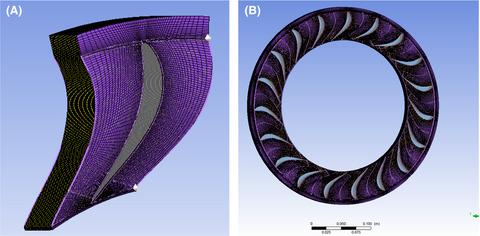当前位置:
X-MOL 学术
›
Energy Sci. Eng.
›
论文详情
Our official English website, www.x-mol.net, welcomes your feedback! (Note: you will need to create a separate account there.)
Simulation study on the flow field of guide vane and impeller of turbo expander
Energy Science & Engineering ( IF 3.8 ) Pub Date : 2019-09-26 , DOI: 10.1002/ese3.477 Bingcheng Liu 1 , Shaoyi Wang 1 , Mengmeng Zhang 1 , Ning Liu 1 , Chuanwei Wang 1 , Wenguang Jia 1
Energy Science & Engineering ( IF 3.8 ) Pub Date : 2019-09-26 , DOI: 10.1002/ese3.477 Bingcheng Liu 1 , Shaoyi Wang 1 , Mengmeng Zhang 1 , Ning Liu 1 , Chuanwei Wang 1 , Wenguang Jia 1
Affiliation

|
In the face of the current energy shortage, organic Rankine cycle (ORC) technology is a way to make efficient use of energy, especially geothermal energy. As the core component of an ORC system, a turbo expander can achieve a high conversion efficiency for geothermal energy and has good development prospects. For low temperature geothermal energy such as 95°C water, R245fa could be chosen as the working fluid. Through preliminary thermal calculations and the MATLAB programming method, the main thermal performance parameters and the aerodynamic parameters, structural parameters, and three‐dimensional modeling of the guide vane and impeller were obtained. The design of the turbo expander was modeled and meshed by the Workbench module using the ANSYS software, and the internal flow path of the expander was numerically simulated by the CFX module. The results showed that there was a small range of wake loss at the trailing edge of the vane flow; impact loss and wake loss occurred at the leading and trailing edges of the impeller blades. At the 30% relative chord strength of the impeller, there was excessive expansion, resulting in a local low‐pressure area and a secondary flow from the hub to the rim.
中文翻译:

涡轮膨胀机导叶和叶轮流场的仿真研究
面对当前的能源短缺,有机朗肯循环(ORC)技术是一种有效利用能源特别是地热能的方法。涡轮膨胀机作为ORC系统的核心部件,可以实现地热能的高转化效率,具有良好的发展前景。对于低温地热能(例如95°C的水),可以选择R245fa作为工作流体。通过初步的热计算和MATLAB编程方法,获得了主要的热性能参数以及导叶和叶轮的空气动力学参数,结构参数以及三维建模。使用ANSYS软件通过Workbench模块对涡轮膨胀机的设计进行建模和网格化,并使用CFX模块对膨胀机的内部流路进行数值模拟。结果表明,叶片流后缘的尾流损失范围很小;反之,尾流损失较小。冲击损失和尾流损失发生在叶轮叶片的前缘和后缘。在叶轮的相对弦强度为30%时,会过度膨胀,从而导致局部低压区域以及从轮毂到轮辋的二次流。
更新日期:2019-09-26
中文翻译:

涡轮膨胀机导叶和叶轮流场的仿真研究
面对当前的能源短缺,有机朗肯循环(ORC)技术是一种有效利用能源特别是地热能的方法。涡轮膨胀机作为ORC系统的核心部件,可以实现地热能的高转化效率,具有良好的发展前景。对于低温地热能(例如95°C的水),可以选择R245fa作为工作流体。通过初步的热计算和MATLAB编程方法,获得了主要的热性能参数以及导叶和叶轮的空气动力学参数,结构参数以及三维建模。使用ANSYS软件通过Workbench模块对涡轮膨胀机的设计进行建模和网格化,并使用CFX模块对膨胀机的内部流路进行数值模拟。结果表明,叶片流后缘的尾流损失范围很小;反之,尾流损失较小。冲击损失和尾流损失发生在叶轮叶片的前缘和后缘。在叶轮的相对弦强度为30%时,会过度膨胀,从而导致局部低压区域以及从轮毂到轮辋的二次流。


























 京公网安备 11010802027423号
京公网安备 11010802027423号